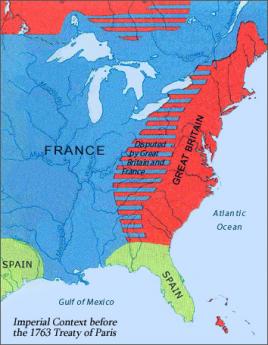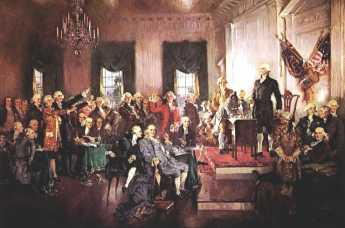Related Topics
Articles of Confederation
The Articles of Confederation were written by John Dickinson, modified by others. Officially unratified for five years, the country was ruled under them in Philadelphia, for thirteen. They taught many lessons, which we sometimes forget we had experienced.
Confederation Congress, 1781-1789
New topic 2012-08-06 12:22:08 description
Popular Passages
New topic 2013-02-05 15:24:06 description
Northwest Ordinance of July 13, 1787: Articles of Confederation at their Best
COMING across the term "Northwest Territory" for the first time, modern students can easily confuse it with the states of Washington and Oregon, more precisely called the Pacific Northwest, thousands of miles to the west. The United States acquired this more eastern Territory from the British -- bounded on the south by the Ohio and Mississippi Rivers below Canada, and West of the Appalachian Mountains -- at the second Treaty of Paris which ended the Revolutionary War in 1783. Before that, the British had acquired it from the French at the first Treaty of Paris, ending the French and Indian War in 1763. Until the Louisiana Purchase in 1803, this land really was the Northwestern tip of American possession, even though it is less than half-way between the Atlantic and Pacific Oceans. It was occupied by Indian tribes who much preferred dealing with wandering British fur traders, to the new threat of permanent occupation by American settler families. In part, bloody warfare with the Shawnee Indians under Tecumseh did somewhat justify the reluctance of the British to give up their chain of forts in Indian Territory friendly to them, but rapid immigration to America from Europe after the end of the war soon generated great westward pressure for settlers to move there. In general, these new immigrants were neither military veterans nor experienced woodsmen and suffered several large massacres from Indians whose homelands were threatened. The Northwest Territory was a dangerous place for unseasoned settlers at the end of the Eighteenth century.
Consequently, it required four years for the new Republic to decide how to handle this sudden expansion of territory it must govern. The question of excluding slavery had already come up, along with the puzzle of managing the masses of raw European immigrants as they encountered and outraged the native Indians. Furthermore, a military alliance, which is what the Articles of Confederation amounted to, is an awkward vehicle for governing an expanding frontier wilderness, especially while it was experimenting with new forms of governance. For one thing, joint ownership by thirteen sovereignties seemed almost certain to tempt one or two of them to take it all over, provoking interstate war and possibly endless disputes between former friends. Most observers in retrospect regard the Northwest Ordinance of the Confederation Congress to be a sensible and workable product, which happened to be just about the last major act of that political body. The Constitutional Convention overlapped it.

|
| Before the French and Indian War. |
The Ordinance under the Articles of Confederation was ratified on July 13, 1787, whereas the Constitutional Convention was in session from May 14 to September 17, 1787. No doubt a smooth transition between the two was under discussion, although the Confederation Congress was an itinerant body, always struggling to produce a quorum and a place to meet. Judging from their behavior after the Constitution was ratified, some undefined proportion of the Confederation Congress may have continued to harbor States Rights resentments at being displaced by a new nationalist government. At the very least, it would only be natural for some of the Congress to be offended that Washington failed to endorse them for the Constitutional Convention. Following that, the advocates of Constitutional ratification were then fairly careless in denouncing the inadequacy of the Articles by citing the failures of the Confederation Congress as examples of it.
The Northwest Ordinance provided for a military government until a civilian one could establish itself. Conquering armies are quite accustomed to the rough uncertainties of keeping a hostile territory subdued while a declared enemy is relentlessly dealt with under a different set of rules. The Congress (soon amended to substitute the President) was to appoint temporary governors and panels of judges. A provisional civilian government was added as soon as five thousand male settlers (each owning fifty acres of land) were resident, and that provisional government was to help devise a state constitution and set of laws as soon as sixty thousand such settlers were resident. The Ordinance allowed the territory to be divided between three to five states, but the borders of five states were laid out from the start. At first, this discordance between laying out the inflexible boundaries for five states, and at the same time allowing for a variable number of states, seems careless to later generations. But the Congress had no idea how fast different states would fill with settlers but assumed it was likely it would fill from East to West. They thus laid out the ghost outlines of five states within the territory, detaching statehoods as the minimum population filled them up.
A carefully planned, three-step progression (from the military, to provisional, to statehood) turned out to be an excellent expedient for managing other new states created by an expanding frontier throughout the Nineteenth century. Those who today complain that the bicameral Legislative branch is implausible, are not merely disregarding the vital need at the Constitutional Convention for a compromise between the large and small states in a Union of three big with ten small. They must also recognize that the frontier would probably expand by acquiring lightly inhabited land and breaking it up into states, followed by immigration from the edges. Many states were destined to begin with small populations, and grow to have big ones. To maintain strict adherence to population limits for new states would probably result in peculiarly-shaped, but densely populated, states on the edges, possibly in large numbers, along with endless quarrels about suspected gerrymandering of the Senate. It may not be an accident that Elbridge Gerry, the namesake of Gerrymandering, was on the committee devising this Ordnance. The U.S. Senate has long been proud of its immunity to gerrymandering, contrasted with the evils the process regularly imposes on the House of Representatives. The Great Compromise of a bicameral legislature, giving equal Senate power to many small states, but House of Representative power to a few big ones, was only weeks from being struck; there may be some connection, here. Although the balance continually shifts, the generalization is still true that America is a Union of a few big states and many small ones. Seemingly, the election rules are not likely to change substantially. Eliminating the Electoral College, much grumbled by the big states is thus also, forever unlikely.

|
| The Varsity Comes Onto the Field |
It seems useful to point out the practical utility of defining citizens who "live" in a district, as being those who probably own land there. The Northwest Territory was a vast expanse of wilderness, much of which soon become the most valuable farmland in the world, with topsoil two feet thick. The rules of this land rush were that it was to be governed by Federal troops until there were five thousand male settlers, presumably the minimum sufficient to defend against hostile Indians. However, the assumption of political power, along with its ability to set the rules, offered a temptation to find ways of making the number unreasonably easy to reach or temporarily composed of a particular political group. Demanding that eligible citizens must each own a liveable plot of farmland probably seemed wise precaution against carpet-bag "voters" being temporarily imported for the voting. A similar provision was soon included in the Constitution, although that is often held up by partisan writers as proof of aristocratic leanings among the Constitutional Framers. With land selling for fifteen cents an acre, it seems more likely it was a practical test of genuine residence, the Eighteenth century equivalent of presenting a driver's license as identification at the polling booth. In both instances, those suspected of impersonating local voters pretend to the great offense at the voicing of any suspicion of it.
The Northwest Territory eventually became Ohio, Indiana, Illinois, Michigan, and Wisconsin, plus a part of Minnesota. The dynamics of migration took unexpected turns. Although Ohio was the seventeenth state, admitted in 1803, Wisconsin was the thirtieth, waiting until 1848 for admission to statehood. For a while, a settlement was more rapidly toward the South, and near the region of the Louisiana Purchase. The Northwest Ordinance was in force without major amendment for almost fifty years.
Part of its durability can be traced to the prohibition of slavery in the Northwest Territory. The existing Southern states were remarkably peaceful about agreeing to slavery prohibition, a reaction said to arise from tobacco growing southern states indifferent to competition to their main crop, from areas with presumably higher labor costs. When the main crop soon turned from tobacco to cotton, the anti-competitive argument apparently had less force. One cannot contemplate the horrendous impending casualties of the Civil War without wondering if massaging of the competition argument might have been put to more imaginative use during the forty-year interval of free soil agitations. Unfortunately, since politicians did not appreciate the price they were about to pay for a policy of drift, they obstructed the (probably) much smaller costs of facing the issue sooner.
Originally published: Tuesday, February 14, 2012; most-recently modified: Wednesday, May 29, 2019